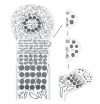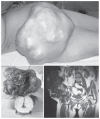Hereditary Multiple Exostoses: a review of clinical appearance and metabolic pattern
- PMID: 27920806
- PMCID: PMC5119707
- DOI: 10.11138/ccmbm/2016.13.2.110
Hereditary Multiple Exostoses: a review of clinical appearance and metabolic pattern
Abstract
Hereditary multiple exostoses (HME) is an inherited genetic condition characterized by the presence of multiple exostoses (osteochondromas). MHE is a relatively rare autosomal dominant disorder, mainly caused by loss of function mutations in two genes: exostosin-1 (EXT1) and exostosin-2 (EXT2). These genes are linked to heparan sulfate (HS) synthesis, but the specific molecular mechanism leading to the disruption of the cartilage structure and the consequent exostoses formation is still not resolved. The aim of this paper is to encounter the main aspects of HME reviewing the literature, in order to improve clinical features and evolution, and the metabolic-pathogenetic mechanisms underlying. Although MHE may be asymptomatic, a wide spectrum of clinical manifestations is found in paediatric patients with this disorder. Pain is experienced by the majority of patients, even restricted motion of the joint is often encountered. Sometimes exostoses can interfere with normal development of the growth plate, giving rise to limb deformities, low stature and scoliosis. Other many neurovascular and associated disorders can lead to surgery. The most feared complication is the malignant transformation of an existing osteochondroma into a secondary peripheral chondrosarcoma, during adulthood. The therapeutic approach to HME is substantially surgical, whereas the medical one is still at an experimental level. In conclusion, HME is a complex disease where the paediatrician, the geneticist and the orthopaedic surgeon play an interchangeable role in diagnosis, research and therapy. We are waiting for new studies able to explain better the role of HS in signal transduction, because it plays a role in other bone and cartilage diseases (in particular malignant degeneration) as well as in skeletal embryology.
Keywords: EXT1; EXT2; HS synthesis; Hereditary Multiple Exostoses; osteochondromas.
Figures





Similar articles
-
Hereditary Multiple Exostoses: Current Insights.Orthop Res Rev. 2019 Dec 13;11:199-211. doi: 10.2147/ORR.S183979. eCollection 2019. Orthop Res Rev. 2019. PMID: 31853203 Free PMC article. Review.
-
The pathogenic roles of heparan sulfate deficiency in hereditary multiple exostoses.Matrix Biol. 2018 Oct;71-72:28-39. doi: 10.1016/j.matbio.2017.12.011. Epub 2017 Dec 24. Matrix Biol. 2018. PMID: 29277722 Free PMC article. Review.
-
Venous malformation may be a feature of EXT1-related hereditary multiple exostoses: A report of two unrelated probands.Am J Med Genet A. 2023 Jun;191(6):1570-1575. doi: 10.1002/ajmg.a.63158. Epub 2023 Mar 4. Am J Med Genet A. 2023. PMID: 36869625
-
Multiple hereditary exostoses (MHE): elucidating the pathogenesis of a rare skeletal disorder through interdisciplinary research.Connect Tissue Res. 2014 Apr;55(2):80-8. doi: 10.3109/03008207.2013.867957. Epub 2014 Feb 12. Connect Tissue Res. 2014. PMID: 24409815
-
Palovarotene Inhibits Osteochondroma Formation in a Mouse Model of Multiple Hereditary Exostoses.J Bone Miner Res. 2018 Apr;33(4):658-666. doi: 10.1002/jbmr.3341. Epub 2017 Nov 30. J Bone Miner Res. 2018. PMID: 29120519 Free PMC article.
Cited by
-
Hsa_Circ_0008035 drives immune evasion of gastric cancer via promoting EXT1-mediated nuclear translocation of PKM2.Transl Oncol. 2024 Oct;48:102004. doi: 10.1016/j.tranon.2024.102004. Epub 2024 Jul 24. Transl Oncol. 2024. PMID: 39053344 Free PMC article.
-
Surgical Approach and Considerations for Compressive Thoracic Intraspinal Osteochondroma in Familial Hereditary Multiple Exostosis.Diseases. 2024 Jul 19;12(7):165. doi: 10.3390/diseases12070165. Diseases. 2024. PMID: 39057136 Free PMC article.
-
Haploinsufficiency of EXT1 and Heparan Sulphate Deficiency Associated with Hereditary Multiple Exostoses in a Pakistani Family.Medicina (Kaunas). 2022 Dec 31;59(1):100. doi: 10.3390/medicina59010100. Medicina (Kaunas). 2022. PMID: 36676722 Free PMC article.
-
The Rizzoli Multiple Osteochondromas Classification revised: describing the phenotype to improve clinical practice.Am J Med Genet A. 2021 Nov;185(11):3466-3475. doi: 10.1002/ajmg.a.62470. Epub 2021 Sep 3. Am J Med Genet A. 2021. PMID: 34477285 Free PMC article.
-
A Rare Case of Hereditary Multiple Exostoses in a Woman.Orthop Nurs. 2024 Mar-Apr 01;43(2):119-122. doi: 10.1097/NOR.0000000000001018. Orthop Nurs. 2024. PMID: 38546687 Free PMC article.
References
-
- Campanacci M. Bone and soft tissue tumors. Bologna: Springer-Verlag Wien GmbH; 1990.
-
- Schmale GA, Conrad EU, III, Raskind WH. The natural history of hereditary multiple exostoses. J Bone Joint Surg Am. 1994;76A:986e92. - PubMed
-
- Ryckx A, Somers JF, Allaert L. Hereditary multiple exostosis. Acta Orthop Belg. 2013;79(6):597–607. - PubMed
-
- Shapiro F, Simon S, Glimcher HJ. Hereditary multiple exostoses. Anthropometric, roentgenographic, and clinical aspects. J Bone Joint Surg Am. 1979;61A:815e24. - PubMed
-
- Wicklund CL, Pauli RM, Johnston D, Hecht JT. Natural history study of hereditary multiple exostoses. Am J Med Genet. 1995;55:43e6. - PubMed
Publication types
LinkOut - more resources
Full Text Sources
Other Literature Sources
Miscellaneous
